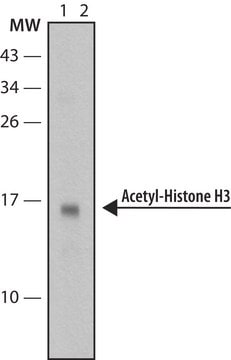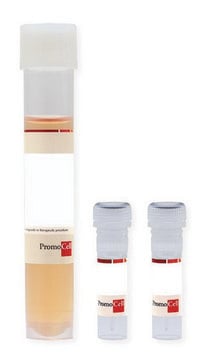04-790-S
Anti-dimethyl-Histone H3 (Lys4) Antibody, clone AW30, Trial Size
culture supernatant, clone AW30, Upstate®
Synonym(s):
H3K4me2, Histone H3 (di methyl K4)
About This Item
Recommended Products
biological source
rabbit
Quality Level
antibody form
culture supernatant
antibody product type
primary antibodies
clone
AW30, monoclonal
species reactivity
human, chicken
manufacturer/tradename
Upstate®
technique(s)
ChIP: suitable (ChIP-seq)
dot blot: suitable
inhibition assay: suitable (peptide)
western blot: suitable
isotype
IgG
NCBI accession no.
UniProt accession no.
shipped in
wet ice
target post-translational modification
dimethylation (Lys4)
Gene Information
human ... H3C1(8350)
General description
Specificity
Immunogen
Application
A 1:1000-1:2000 dilution of this lot detected dimethyl histone H3 (Lys4) in HeLa acid extracts.
Western Blot Analysis:
A 1:2,000 to 1:10,000 dilution of a previous lot detected methylated histone H3 in acid extracted proteins from HeLa cells. The antibody did not detect unmethylated recombinant Histone H3.
ChIP-seq Analysis:
Representative lot data. Chromatin immunoprecipitation was performed using the Magna ChIP HiSens kit (cat# 17-10460), Anti-dimethyl-Histone H3 (Lys4) antibody (2 µl cat# 04-790-S), 20 µL Protein A/G beads, and 1e6 crosslinked HeLa cell chromatin followed by DNA purification using magnetic beads. Libraries were prepared from Input and ChIP DNA samples using standard protocols with Illumina barcoded adapters, and analyzed on Illumina HiSeq instrument. An excess of sixteen million reads from FastQ files were mapped using Bowtie (http://bowtie-bio.sourceforge.net/manual.shtml) following TagDust (http://genome.gsc.riken.jp/osc/english/dataresource/) tag removal. Peaks were identified using MACS (http://luelab.dfci.harvard.edu/MACS/), with peaks and reads visualized as a custom track in UCSC Genome Browser (http://genome.ucsc.edu) from BigWig and BED files. The highest 25% of peaks identified in the 04-790 and 05-1338 datasets showed 92 and 90% overlap with peaks identified in the ENCODE H3K4me2 BROAD Histone track for HeLa S3.
Dot Blot Analysis:
Absurance Histone H3 Antibody Specificity Array (Cat. No. 16-667) and Absurance Histone H2A, H2B, H4 Antibody Specificity Array (Cat. No. 16-665), which contain histone peptides with various modifications were probed with Cat. No 04-790, Anti-dimethyl Histone H3 (Lys4), clone AW30 at 1:1000 dilution. Proteins were visualized using a Donkey anti-Rabbit IgG conjugated to HRP and a chemiluminescence detection system.
Peptide Inhibition Analysis:
2 μM of a histone H3 peptide containing dimethyl-lysine 4 abolished detection of histone H3 by a previous lot of antibody in immunoblot analysis of HeLa acid extracts. No signal reduction was observed with histone H3 peptides containing either monomethyl or trimethyl-lysine 4 modifications
Epigenetics & Nuclear Function
Histones
Quality
Linkage
Physical form
Storage and Stability
For maximum recovery of product, centrifuge the vial prior to removing the cap.
Analysis Note
HeLa acid extracts
Legal Information
Disclaimer
Not finding the right product?
Try our Product Selector Tool.
Storage Class
12 - Non Combustible Liquids
wgk_germany
WGK 1
flash_point_f
Not applicable
flash_point_c
Not applicable
Certificates of Analysis (COA)
Search for Certificates of Analysis (COA) by entering the products Lot/Batch Number. Lot and Batch Numbers can be found on a product’s label following the words ‘Lot’ or ‘Batch’.
Already Own This Product?
Find documentation for the products that you have recently purchased in the Document Library.
Our team of scientists has experience in all areas of research including Life Science, Material Science, Chemical Synthesis, Chromatography, Analytical and many others.
Contact Technical Service








